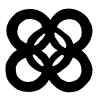Nov 06, 2015
Adinkra Cloth Symbols and Mathematics - Part 2
Adinkra Cloth Symbols and Mathematics
The following is excerpted from ďThe Oxford Encyclopedia of African Thought edited by Edited by F. Abiola Irele and Biodun Jeyifo
The mathematical significance of adinkra emerges in the symmetry between aesthetic form and mathematical principles. This correlation emerges in symmetry, one of the central aspects of aesthetic value. The forms of symmetry evident in adinkra include the bilateral, topological, fractal, rotational, and centripetal. The evocative power of the designs also facilitates the simulation of a host of ideational possibilities that could arise from contemplating these shapes even when these significations are not part of the traditional conceptions attributed to the symbols, This extrapolative possibility is demonstrated by the similarities between Classical Adinkra and the mathematical technology developed by James Gates and Michael Faux, which they first named Adinkras and later Adinkrammatics, in recognition of the Classical Adinkra corpus.
One of the most pervasive forms of symmetry evident in Adinkra is bilateral symmetry, in which two parts of one form are identical. The bilateral symmetry of kuntankatan [shown in the attached picture], for example, is realized by the spatial juxtaposition of two pairs of circles, each pair composed of one circle on top of the other, and all four circles tangent, the entire group forming a quadrilateral, with a fifth circle intersecting the other four.
Kuntankantan symbolizes the idea of arrogance. It would be interesting to find out the artistís rationale for correlating such a sublimely beautiful form with such an unlovely concept. The implied warning against this negative quality remains significant, particularly when evoked by such a memorable visual form. The beauty of the design, on the other hand, enables it to achieve more than this traditional purpose. The symbolís amplification of the centripetal symmetry through which emerges another geometric form, the quadrilateral, creates balance between similarity and difference, that often marks the most pleasing aesthetic forms, from music to mathematics.


